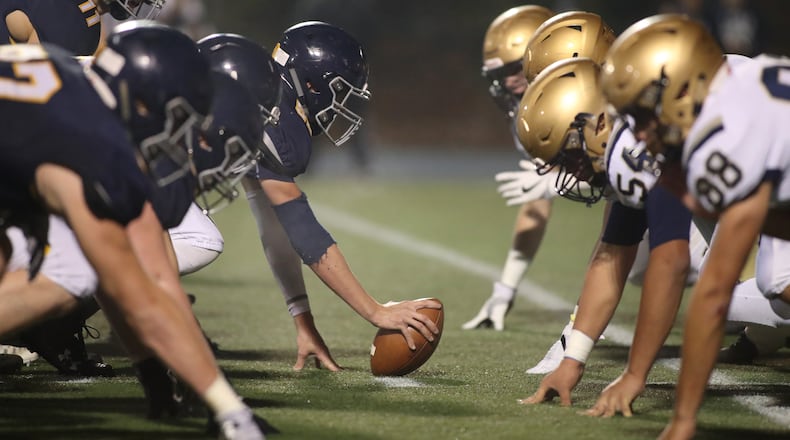Carrollton, St. Pius and Woodward Academy have reason to be especially nervous about the latest plan to increase the GHSA’s reclassification multiplier. Buford, Calhoun and Lovett might be fine with it.
The GHSA’s reclassification committee will meet again Monday to discuss reclassifying its 450-plus member schools for the two-year cycle beginning in 2022-23.
The plan gaining the most support, proposed last week, would increase the out-of-zone enrollment multiplier to 2.5 from the 2.0 used for the current cycle. A 3.0 multiplier also was proposed. Multipliers are designed to move certain schools – mainly city and private schools – into higher classifications by counting their out-of-zone students more than once. It’s believed those schools’ ability to draw students out of zone is an unfair competitive advantage.
The latest plan also calls for no cap on the number of classifications a school can be moved up by the multiplier. Currently, there is a two-class limit along with the assurance that the multiplier can’t move a school into 7A, the highest class.
Below are rough projections on the impact of 2.0, 2.5 and 3.0 multipliers with cap removals on private and city schools, their designed target. The projections are based on enrollment numbers from the spring because the department of education hasn’t released fall enrollment totals. The projections assume that each school’s out-of-zone percentages will remain roughly the same as 2019, the last time they were compiled. They also assume that schools with 550 or fewer students will be in Class A regardless.
Among the takeaways:
⋅ St. Pius and Woodward Academy could end up in Class 7A with the most aggressive multiplier. They won appeals in 2019 to keep them below 6A. It’s unknown if their arguments would hold weight again. Greater Atlanta Christian also won a 2019 appeal to avoid 4A but could wind up in 6A with a 3.0 multiplier.
⋅ Unless its enrollment statistics have changed since 2019, Lovett might need a 3.0 multiplier to dislodge it from Class 2A. It was Lovett’s all-sports success (five state titles in 2020-21) along with that of Pace Academy, another current 2A school, that re-energized the movement to mitigate private-school domination. In 2019, Lovett reported 37% out-of-zone students. Those at St. Pius, Woodward Academy and GAC exceeded 90%. Also, Pace Academy has enrollment below the Class A threshold and is not included in the projections.
⋅ Carrollton in 2019 reported more out-of-zone students than any city school at around 34% and could end up in Class 7A if the 7A blockade is lifted. Valdosta, already on the 7A/6A bubble, also seems destined for the highest classification despite only 8% out-of-zone enrollment. Similarly, Gainesville might go down from 7A because of enrollment changes.
⋅ Buford’s placement in 6A and Calhoun’s in 5A might be impervious to multipliers. Both are on the lower end of their classifications in enrollment.
⋅ Increasing multipliers can cause collateral damage. Chamblee, a Class 5A DeKalb County charter school, is the GHSA’s 101st-largest school by enrollment but ranks 39th with a 2.5 multiplier on its 31.5% out-of-zone population. That would put the Bulldogs in Class 7A. The GHSA granted several appeals in 2019 that seemed to solve those concerns, however.
The GHSA could approve a new reclassification plan as early as Oct. 3-4. Monday’s reclass meeting, open to the public, will start at 11 a.m. at the Thomaston Civic Center.
This chart shows how three multipliers would affect the 23 city and private schools above Class A using their most recent enrollment and out-of-zone percentages. For example, Buford remains in Class 6A using 3.0, 2.5 or 2.0 multipliers, but St. Pius would be pegged for 6A only with a 2.0 multiplier.
Class 7A
City schools: Carrollton (3.0/2.5), Marietta (all multipliers), Valdosta (all)
Private schools: St. Pius (3.0/2.5), Woodward Academy (3.0/2.5)
Class 6A
City schools: Buford (all), Carrollton (2.0), Cartersville (3.0), Dalton (all), Gainesville (all), Rome (all)
Private schools: Blessed Trinity (3.0/2.5), Greater Atlanta Christian (3.0), Marist (3.0), St. Pius (2.0), Woodward Academy (2.0)
Class 5A
City schools: Calhoun (all), Cartersville (2.5/2.0), Decatur (all), Jefferson (3.0)
Private schools: Blessed Trinity (2.0), GAC (2.5), Marist (2.5)
Class 4A
City schools: Jefferson (2.5/2.0)
Private schools: Benedictine (3.0/2.5), GAC (2.0), Marist (2.0), Westminster (3.0/2.5)
Class 3A
City schools: Bremen (3.0/2.5)
Private schools: Benedictine (2.0), Lovett (3.0), Riverside Military (3.0, 2.5), Westminster (2.0)
Class 2A
City schools: Bremen (2.0), Thomasville (all)
Private schools: Lovett (2.5/2.0), Riverside Military (2.0)
Produced by Georgia High School Football Daily, a free e-mail newsletter. To join the mailing list, click here.
About the Author
The Latest
Featured


